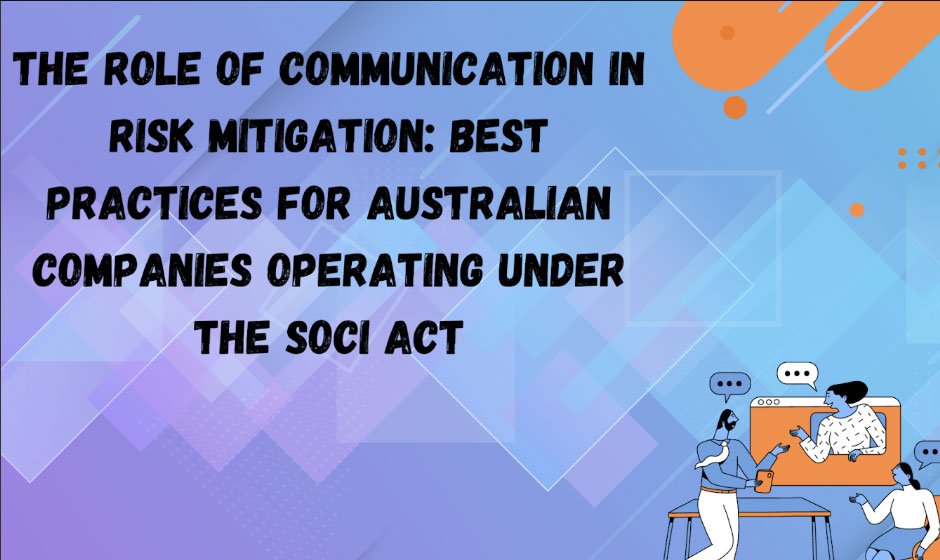In today’s interconnected world, the security of critical infrastructure is a paramount concern for nations worldwide, including Australia. The Security of Critical Infrastructure Act 2018 (SOCI Act) was introduced to address this pressing issue, aiming to protect Australia’s essential services from emerging cyber threats and safeguard the nation’s well-being.
As a responsible business owner or operator in a critical infrastructure sector, you understand the gravity of this legislation and the importance of compliance. Navigating the complexities of the SOCI Act might seem daunting, but rest assured – we’re here to guide you through the process with a comprehensive and authoritative approach.
This blog post will delve into the pivotal role of effective communication in mitigating risks and ensuring compliance with the SOCI Act’s requirements. Our aim is to empower you with practical insights and best practices, presented in a reader-friendly and conversational manner, to help protect your operations and contribute to the overall security of Australia’s critical infrastructure.
Understanding the SOCI Act
At the heart of the SOCI Act lies the Security of Critical Infrastructure (Critical Infrastructure Risk Management Program Rules) LIN 23/006 2023, which outlines specific requirements for responsible entities. These entities, defined as owners, operators, or direct interest holders in critical infrastructure assets, are mandated to develop and implement comprehensive risk management programs. The CIRMP obligations cover a broad range of security aspects, including cyber security, where measures must be implemented to protect against cyber threats and unauthorized access.
Additionally, personnel security is a key aspect, ensuring that personnel with access to critical infrastructure assets are appropriately vetted and trained. Supply chain security is another crucial element, safeguarding the integrity of supply chains and identifying potential vulnerabilities. Lastly, physical security measures are necessary to protect physical assets from unauthorized access or damage.
Critical Infrastructure Assets Covered by the SOCI Act
By casting a wide net, the Act aims to address the interconnected nature of critical infrastructure and the potential cascading effects of any disruptions or breaches. These include:
- Critical electricity assets
- Critical water assets
- Critical port assets
- Critical gas assets
- Critical liquid fuel assets
- Critical aviation assets
- Critical financial market infrastructure
- Critical food and grocery assets
- Critical freight infrastructure assets
- Critical broadcasting assets
- Designated hospitals
By casting a wide net, the Act aims to address the interconnected nature of critical infrastructure and the potential cascading effects of any disruptions or breaches.
Communication’s Role in the CIRMP Obligations
Effective communication is the backbone of any successful risk management program, and the SOCI Act’s CIRMP obligations are no exception. Establishing clear communication channels within organizations and with external partners is crucial for identifying hazards, minimizing risks, and ensuring compliance. Open communication enables the timely identification of potential threats or vulnerabilities, allowing for proactive measures to be taken. This early detection is facilitated by streamlined communication channels, which also facilitate swift and coordinated responses to mitigate risks and minimize the impact of incidents.
Moreover, effective communication fosters collaboration between various stakeholders, leveraging collective expertise and resources for comprehensive risk management strategies. Regular updates and transparency in risk management strategies ensure that all relevant parties are informed and aligned with the SOCI Act’s requirements, further underscoring the pivotal role of communication in achieving compliance assurance.
Best Practices for Risk Management Communication
To leverage the power of communication effectively, companies should adopt the following best practices:
- Establish a dedicated risk management team: Assign a team responsible for overseeing risk management activities, including communication protocols and incident response procedures.
- Implement secure communication channels: Utilize secure and reliable communication platforms to facilitate the exchange of sensitive information related to risk management.
- Foster a culture of transparency: Encourage open and transparent communication throughout the organization, promoting a proactive approach to risk identification and mitigation.
- Conduct regular training and awareness programs: Educate employees at all levels about the importance of risk management, communication protocols, and their roles in ensuring compliance.
- Collaborate with industry partners and regulatory bodies: Engage in dialogue with industry peers, experts, and relevant regulatory authorities to stay informed about best practices, emerging threats, and compliance updates.
- Regularly review and update risk management strategies: Continuously assess and refine communication strategies and risk management plans to address evolving threats and changing business environments.
Implementing Cyber and Information Security Measures
One of the critical components of the SOCI Act is the requirement for responsible entities to comply with recognized cybersecurity frameworks by August 17, 2024. This mandate underscores the importance of robust cyber and information security measures in protecting critical infrastructure assets.
The chart below illustrates the alarming rise in criminal phishing trips, a common form of cyber attack, in Australia over the past few years, further emphasizing the need for stringent cybersecurity measures.
Australian companies operating under the SOCI Act can choose from several cybersecurity frameworks, including:
- The Essential Eight Maturity Model: Developed by the Australian Cyber Security Centre (ACSC), this framework outlines eight essential mitigation strategies to protect against cyber threats.
- AS ISO/IEC 27001:2015: An internationally recognized standard for information security management systems, providing a structured approach to managing and mitigating information security risks.
Implementing these frameworks not only ensures compliance with the SOCI Act but also safeguards companies from potential cyber-attacks, data breaches, and other security incidents that could disrupt operations and compromise critical infrastructure.
Frequently Asked Questions
- What is the significance of the SOCI Act for Australian businesses?
The SOCI Act aims to protect Australia’s critical infrastructure from emerging cyber threats and other risks. By mandating risk management programs and cybersecurity measures, the Act helps ensure the resilience and continuity of operations for businesses in critical sectors, safeguarding the nation’s well-being.
- How can companies ensure compliance with the CIRMP obligations?
Companies can ensure compliance by implementing comprehensive risk management programs that address cyber, personnel, supply chain, and physical security aspects. Adopting recognized cybersecurity frameworks like the Essential Eight Maturity Model or AS ISO/IEC 27001:2015 is also crucial. Regular reviews, updates, and effective communication strategies are key to maintaining compliance.
- What are the penalties for non-compliance with the SOCI Act?
The SOCI Act outlines various penalties for non-compliance, including substantial fines and potential criminal charges. Responsible entities that fail to comply with the Act’s requirements may face fines of up to $11 million for corporations or $2.2 million for individuals, as well as potential imprisonment for up to five years.
Conclusion
As Australian businesses navigate the complexities of the SOCI Act, the role of effective communication in risk mitigation cannot be overstated. By establishing clear communication channels, fostering a culture of transparency, and collaborating with relevant stakeholders, companies can proactively identify and address potential threats to their critical infrastructure assets.
Implementing best practices for risk management communication, coupled with adopting recognized cybersecurity frameworks, will not only ensure compliance with the SOCI Act but also contribute to the overall resilience and security of Australia’s critical infrastructure.
Take the first step towards safeguarding your operations and protecting the nation’s well-being by conducting a comprehensive risk assessment and developing a robust communication strategy aligned with the SOCI Act’s requirements.






